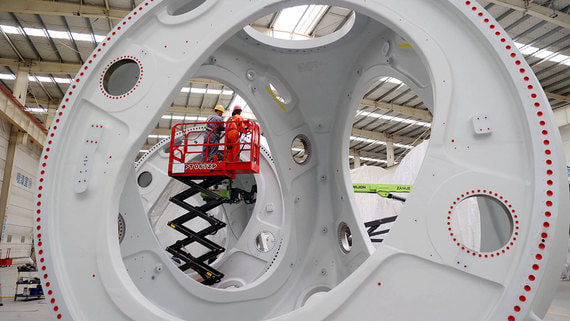Slowdown in industrial activity in China pulls down the global economy
[ad_1]

In July, activity in the manufacturing sector of key Asian countries continued to slow down following China. This follows from preliminary estimates of the Purchasing Manager’s Index (PMI) in industry: the indexes are based on surveys of local manufacturers on how they evaluate their performance and business conditions.
A PMI below 50 points means a contraction in manufacturing activity, above 50 means growth. The July index in Japan’s industry, according to Jibun Bank Japan, fell to 49.6 points compared to 49.8 in June against the backdrop of weak exports: overseas sales of Japanese manufacturers are declining for the 17th month. In neighboring South Korea, S&P Global’s manufacturing PMI rose to 49.4 in July from 47.8 in June, but remains below the key 50-point mark for the 13th consecutive month.
The situation is worse in Taiwan: its PMI index, according to S&P Global, fell to 44.1 points in July from 44.8 in June. “Production conditions continued to deteriorate sharply at the beginning of the third quarter,” analysts say, and “a steady decline in consumer demand” has not disappeared. Vietnam’s July PMI edged up to 48.7 from 46.2, but local firms’ inventories increased in July, S&P Global notes in a report on Vietnam.
The first to continue reducing activity in the manufacturing sector in July was officially announced by China. According to the National Statistical Administration (GSU) of the People’s Republic of China on July 31, PMI in the industry rose only to 49.3 points from 49 points in June and 48.8 points in May, remaining below 50 points. China’s GDP growth in the second quarter accelerated to 6.3% in annual terms against 4.5% in the first quarter, but this is still less than the consensus forecast of Western analysts for the specified period – 7.3%. In the first half of the year, China’s GDP grew by 5.5%.
According to the July forecast of the International Monetary Fund, economic growth in Asia should still accelerate in 2023 – to 5.3% from 4.5% in 2022. The manufacturing sector is expanding in Indonesia and India. In Indonesia, manufacturing PMI rose from 52.5 in June to 53.3 in July, driven by rising domestic demand. Indonesian producers stepped up their buying activity, leading to the fastest stockpiling of raw materials on record. “This marks the 23rd consecutive month of improvement in the sector, the latest improvement being the fastest since September,” S&P Global said in a report on Indonesia. Industrial PMI of India is estimated in July at 57.7 points – almost no changes since June (57.8).
Asian countries are closely connected with each other: the volume of China’s trade even with Taiwan in 2022 is one and a half times greater than with Russia, says Georgy Ostapkovich, director of the HSE ISSEK Center for Market Research. The sluggish recovery of the Chinese economy has a huge impact on the region, agrees Sergey Lukonin, head of the economics and politics sector of China at IMEMO RAS. This, he says, is true for Taiwan, Vietnam and South Korea. But Japan’s July figures are a reflection of problems not only in trade with China, but also domestic ones: this is a “lost decade” of slow growth, an aging Japanese population, and a reduction in labor resources. Demographics are also putting pressure on South Korea’s performance, while the booming populations of India and Indonesia are increasing consumption of goods.
The Chinese economy has accumulated a number of systemic problems, Lukonin points out. Business debt there at the end of 2022 is $51.87 trillion, or 295% of the country’s GDP, and the share of the most able-bodied population (25-35 years old) in the economy is declining exponentially. China’s reorientation towards stimulating domestic demand, announced by the National Development and Reform Commission on July 31, may indicate a decrease in the role of ties with foreign partners – and this makes the announced goal of 5-6% GDP growth in the country almost unattainable, Ostapkovich fears. Geopolitical risks around Taiwan also affect the Chinese economy: the increase in military-industrial complex production has almost no effect on consumption and income growth, he points out. U.S. trade restrictions also play a role, adds Ostapkovich.
One of the reasons for the sluggish recovery of the industry in China and Asia are the measures of the US and EU monetary authorities to tighten their monetary policy, said Associate Professor of the Department of Corporate Governance and Innovation of the Russian University of Economics. G. V. Plekhanov Anatoly Kolesnikov. This leads to a decrease in effective demand, a reduction in the number of orders to Chinese and Asian manufacturers, he explains. Since Southeast Asia is focused on foreign demand, the situation creates risks for the economies of the region, reinforces fears of long-term stagnation in demand, the expert points out. China’s problems are systematic, its current economic slowdown is not a short-term, one-time phenomenon, adds Ostapkovich. They will put significant pressure on the growth of East Asia, which, in turn, will slow the dynamics of world GDP by about 0.5 percentage points per year, he believes. For Russia, a slowdown in China and Asia as a whole will mean a loss of export earnings, the expert concludes.
[ad_2]
Source link






